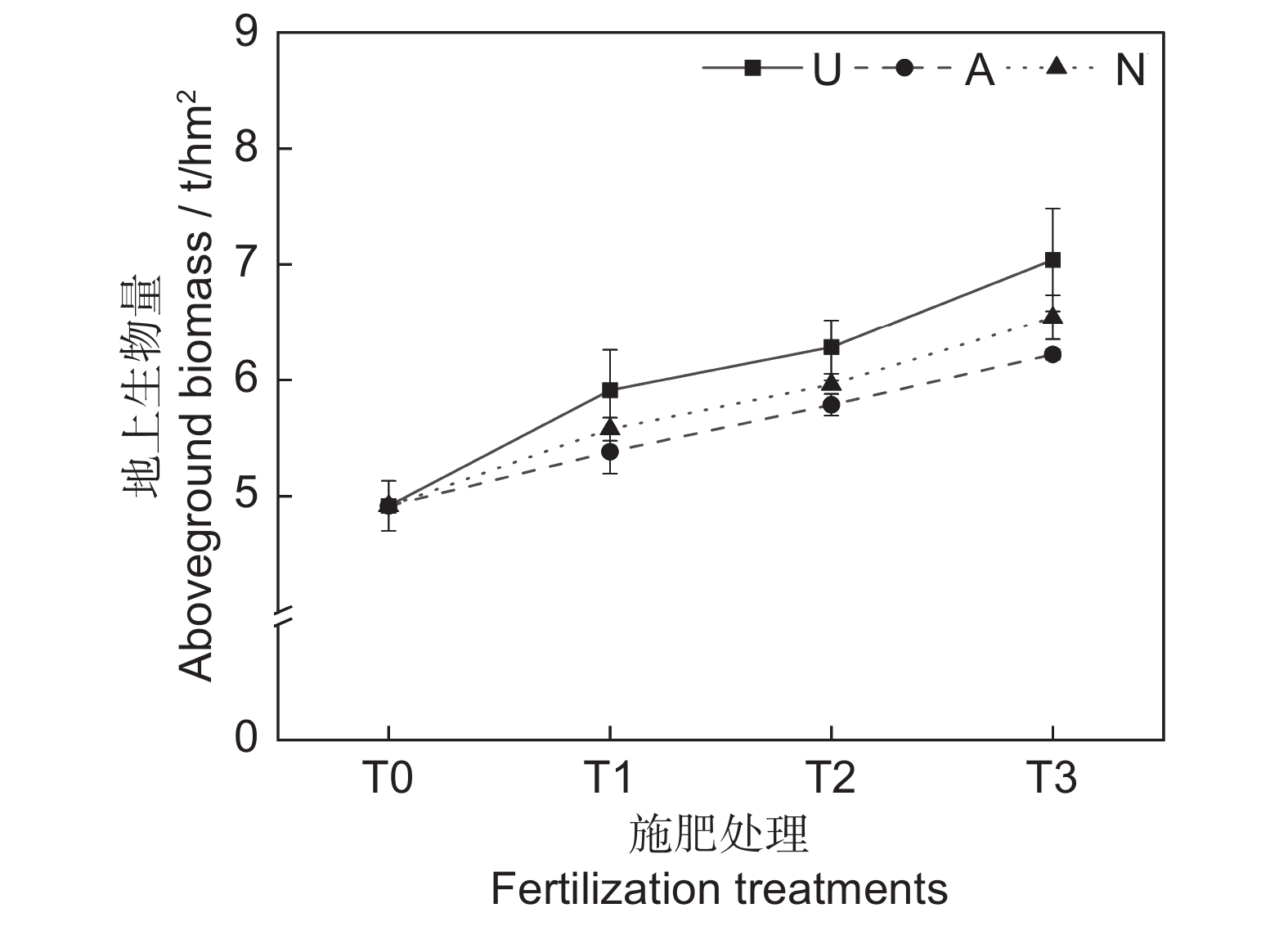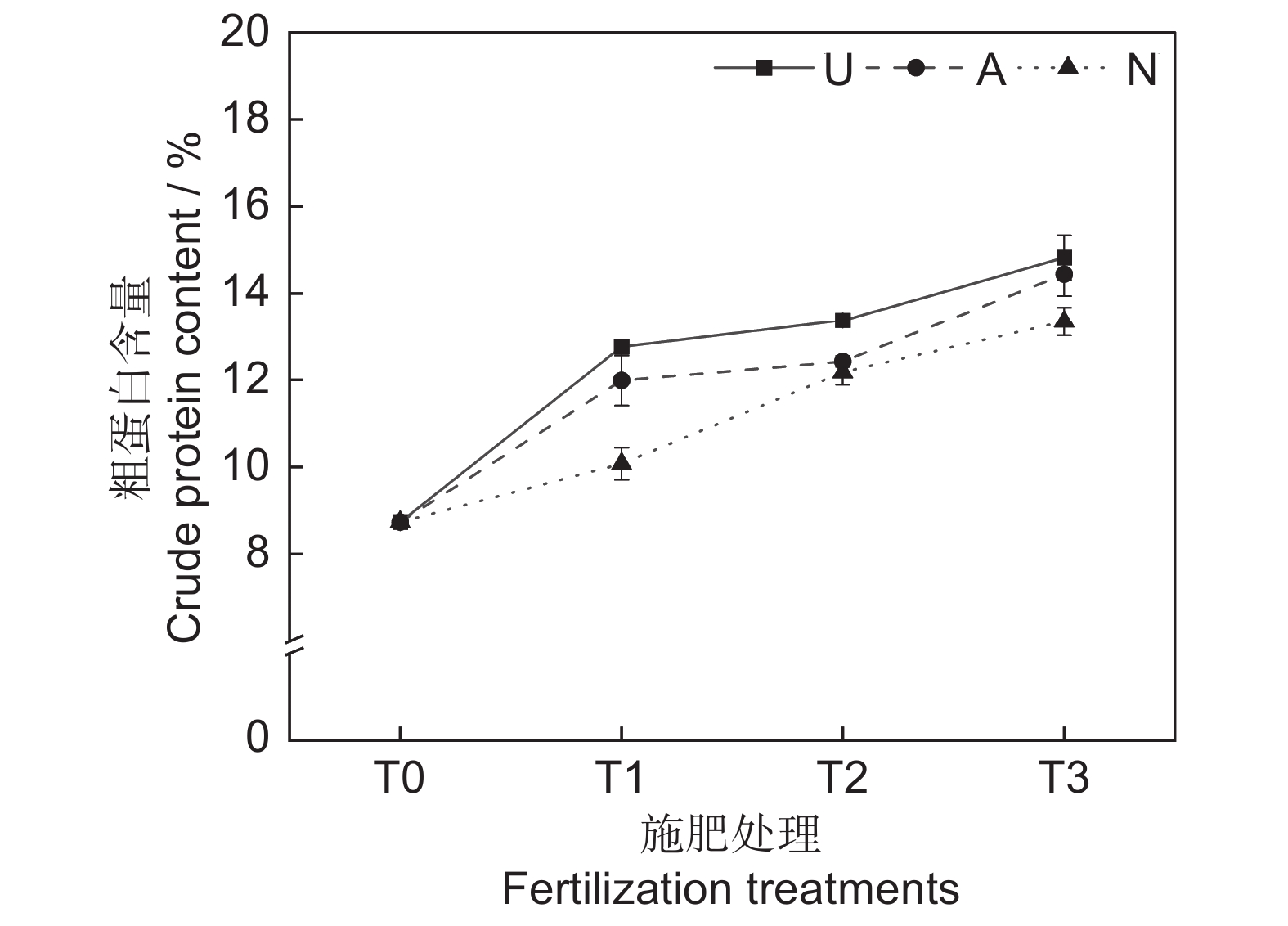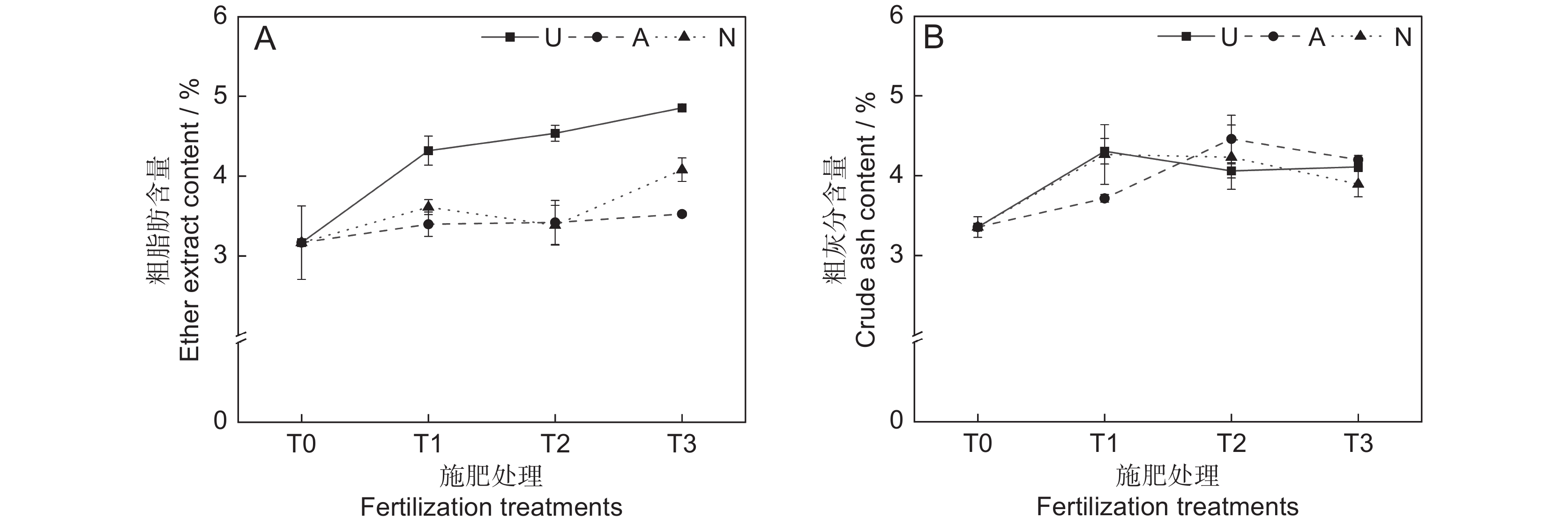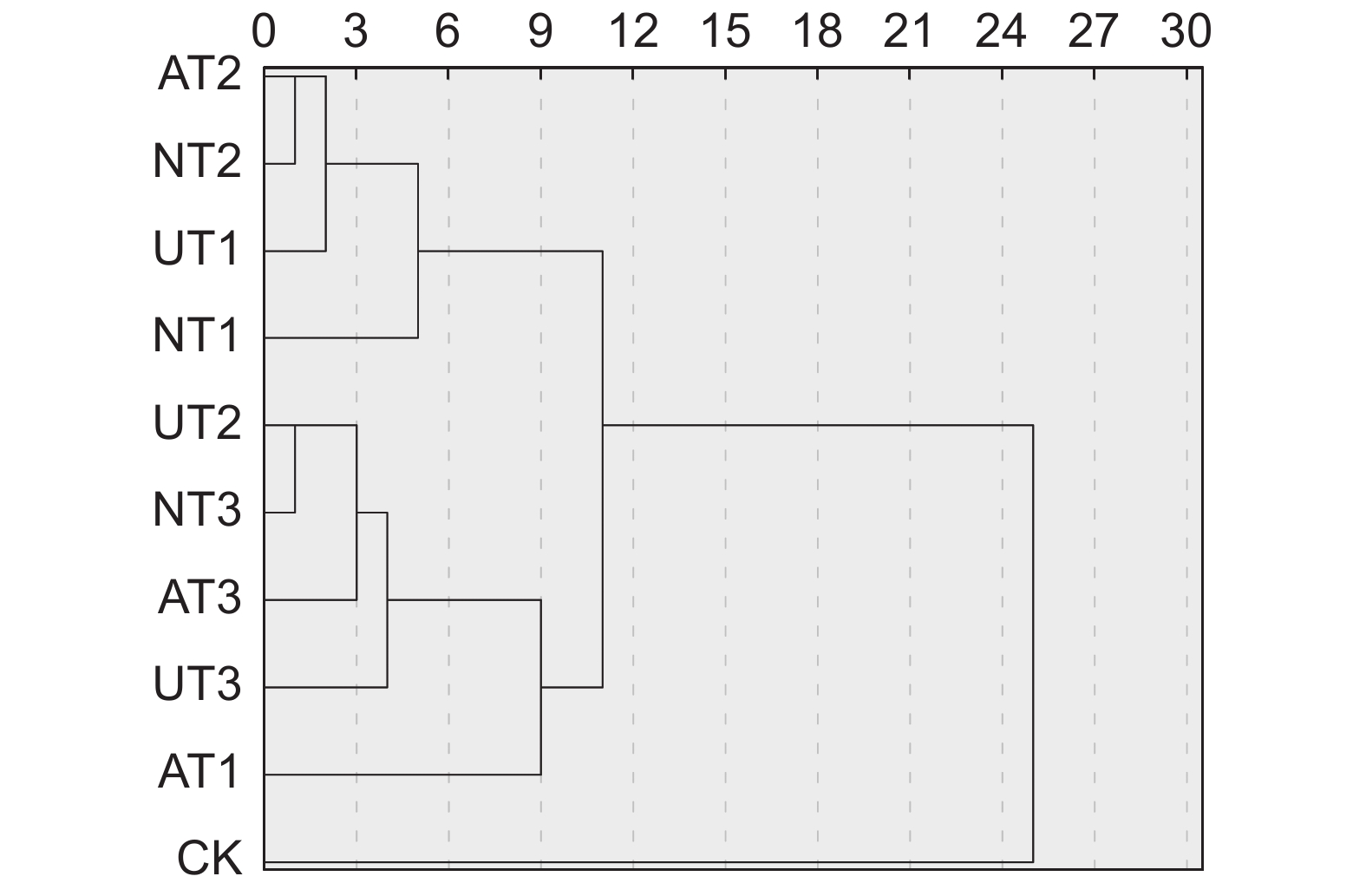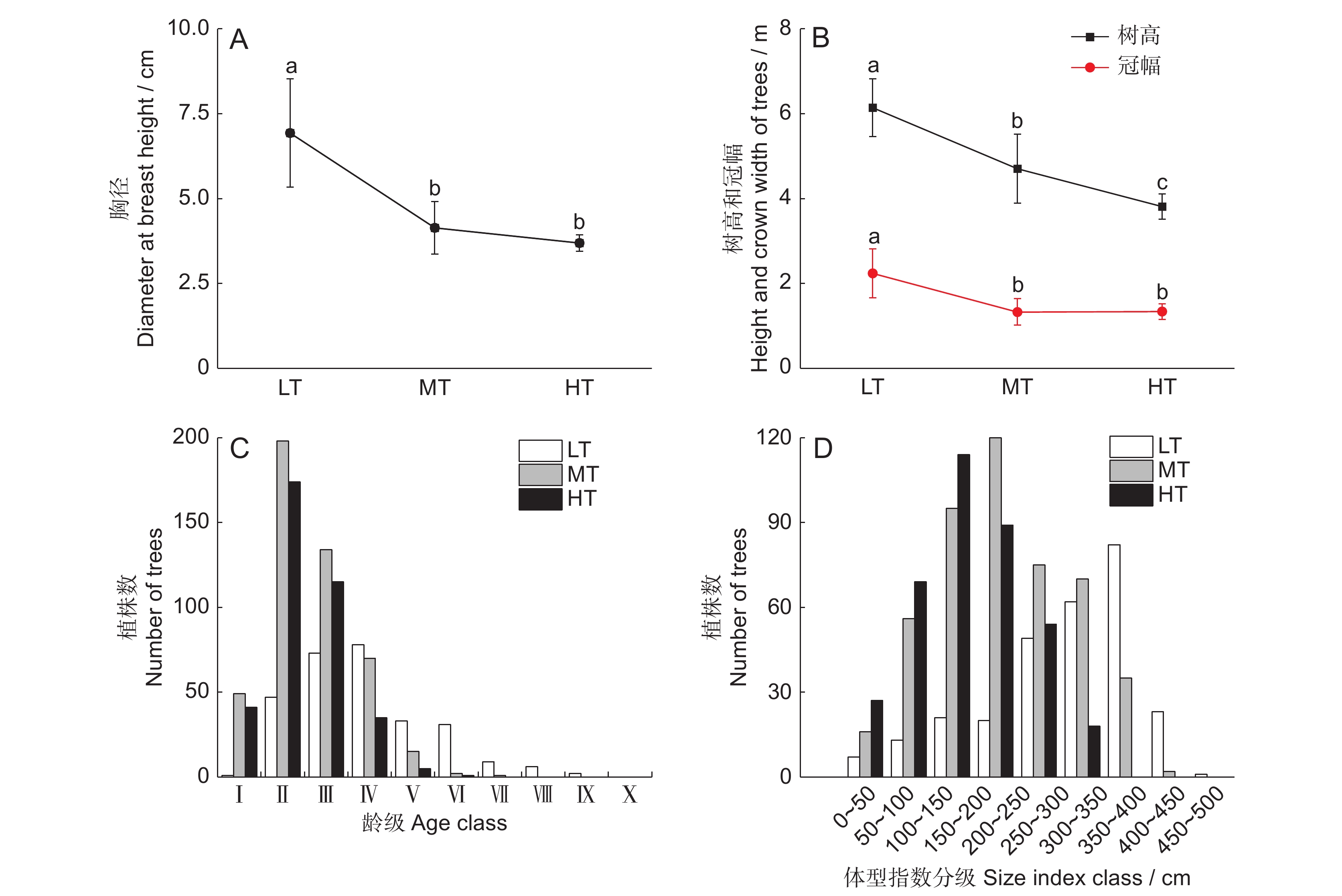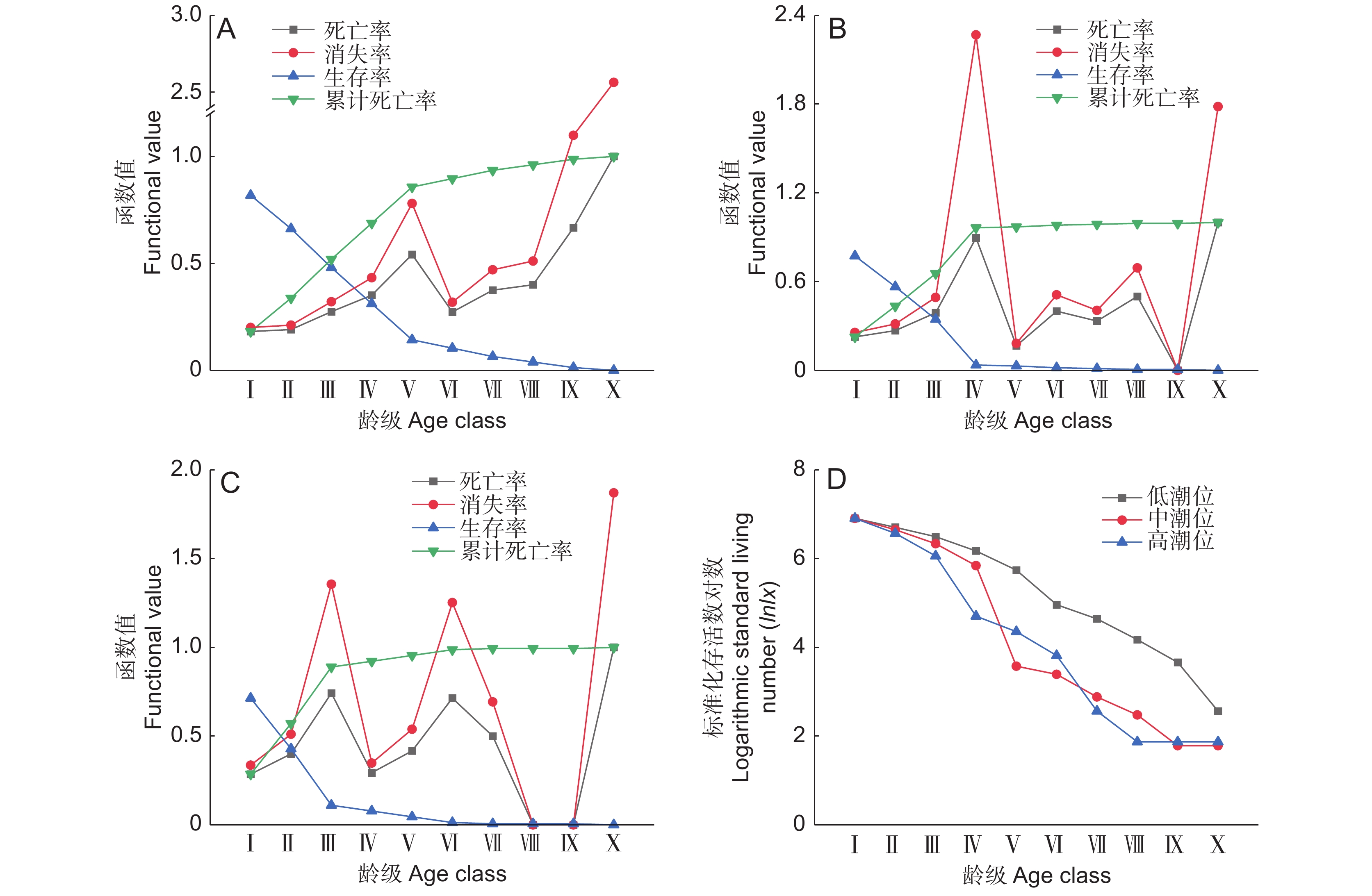Comparative study on the community characteristics and population dynamics of Bruguiera sexangula (Lour.) Poiret at different intertidal elevations in Dongzhaigang National Nature Reserve
-
摘要:
为了解不同生境下海莲(Bruguiera sexangula (Lour.) Poiret)的群落特征和种群动态变化,合理利用与保护现有红树资源,对海南东寨港国家级自然保护区不同潮位下海莲的群落特征、年龄结构、分布格局、静态生命表以及生存函数等进行了研究。结果显示:(1)海莲为群落优势树种,群落的物种多样性指数、均匀度指数以及林分密度随潮位升高逐渐增加,而海莲的重要值、胸径、树高以及冠幅随潮位升高逐渐降低;(2)海莲种群在空间上呈现聚集分布格局,不同潮位的龄级结构分布不同,低潮位种群为“凸”型而中高潮位种群为倒“J”型;(3)海莲种群的存活曲线在不同潮位上存在差异,低潮位植株死亡率在各龄级中相近,为Deevey-Ⅱ型,中高潮位植株死亡率在低龄级阶段高,在高龄级阶段相对稳定,为Deevey-Ⅲ型;(4)不同潮位海莲种群的生存率和累计死亡率函数平衡点均在幼苗阶段,第Ⅴ龄级后各潮位生存函数曲线的变化幅度变小。因此,不同潮位下海莲的群落特征和种群动态有明显差异。研究结果为该区域红树植物的保护及优化管理提供了重要的基础数据。
Abstract:Understanding how intertidal elevation influences the community characteristics and population dynamics of Bruguiera sexangula (Lour.) Poiret is essential for the effective conservation and sustainable management of mangrove ecosystems. This study investigated variations in community characteristics, age structure, spatial distribution pattern, static life-table parameters, and survival functions of B. sexangula along an intertidal gradient in the Hainan Dongzhaigang National Nature Reserve. Results showed the following key findings: (1) B. sexangula was the dominant species in the community. Species diversity, Pielou index, and stand density increased with increasing intertidal elevation, while the importance value, diameter at breast height, tree height, and crown width of B. sexangula decreased. (2) The spatial distribution pattern of B. sexangula exhibited significant clumping. The diameter distribution exhibited a convex-shaped pattern at low intertidal elevations and an inverted J-shaped pattern at both mid and high intertidal elevations. (3) Survival curves varied with intertidal elevation. Low intertidal zones exhibited a Deevey Type Ⅱ curve, while mid and high intertidal elevations showed Deevey Type Ⅲ curves. (4) The equilibrium points of survival and cumulative mortality functions occurred during the seedling stage across all intertidal elevations, and the magnitude of changes in the survival function curves at each intertidal elevation decreased after age Ⅴ. These findings demonstrate that intertidal elevation strongly affects the community characteristics and population dynamics of B. sexangula. This study provides critical baseline data for the protection and optimized management of mangrove ecosystems, particularly in regions experiencing dynamic intertidal changes.
-
高寒草地是青藏高原最主要的生态系统,是维护国家生态安全和改善青藏高原地区农牧民生活质量的重要保障[1]。在过去几十年里,受人类活动和自然因素的影响,高寒草地的生产和生态功能急剧下降,造成大面积土地裸露和草畜不平衡等诸多问题[2]。最近,经过相关领域学者们的不断探索实践,我国高寒草地退化的趋势明显改善,植被覆盖度大幅提升,水土流失和荒漠化基本遏制[3]。然而,青藏高原地区气候寒冷,有机质分解较慢,土壤微生物活性较低[4],导致退化草地治理周期较长,草畜矛盾仍未能有效解决。因此,在退化草地恢复的同时,建植多年生人工草地便成为满足生产和生态功能需求的重要手段。在实践中发现,多年生高寒栽培草地在建植2~3年后地上生物量达到峰值,第4年开始其地上生物量逐年下降,且饲草品质普遍较低[5]。究其原因,与青藏高原地区土壤氮限制密切相关[6]。青藏高原地区土壤氮限制极其严重,加之气温较低,严重抑制了与氮有关的功能微生物的活性,导致生产力较低[6]。此外,多年生牧草常年吸收土壤中的营养物质,导致土壤养分贫瘠,进而造成草地减产[7]。综合两方面的原因,氮添加成为提升多年生栽培草地生产功能的直接手段。
氮素形态和施氮水平是草地氮肥管理的两项重要内容,对植物生长发育起着关键调节作用。根据化合物形态可将氮肥分为铵态氮肥(A)、酰胺态氮肥(U)和硝态氮肥(N)等多种类型,不同形态氮肥均能促进植物的生长,但在土壤中的转化机制不同,导致植物的干物质分配和营养积累存在差异[8]。植物可以吸收利用的土壤氮素主要为硝态氮和铵态氮,氮素形态对不同植物生长发育的影响存在差异,氮肥形态是影响肥效的主要因素之一[9]。施用不同形态氮素会影响作物的根系发育及碳氮代谢等生理进程,进而影响植株生物量的积累。同时,氮素形态还会影响糖、激素、维生素和生物碱等各种化学物质的合成,进而影响植物的品质[10]。向雪梅等[11]在高寒区的施氮研究表明,酰胺态氮能保证植物较高的氮素利用率和较低的氮损失率,是提高植物生产力最佳的氮素形态,而Guo等[12]研究发现,硝态氮能促进野牛草(Buchloe dactyloides (Nutt.) Engelm.)的营养繁殖和品质积累。两种结果不一致的主要原因是不同植物对氮素形态的需求存在差异,故应根据植物类型和生存环境设置合理的氮源。对于青藏高原地区多年生高寒栽培草地而言,哪种氮素形态更有利于生产力和营养品质的积累不得而知。此外,研究施氮水平对植物生产性能的影响并确定合理的氮添加量也是科学添加氮肥的关键[13]。以往研究证实,合理的氮添加量是保证植物生产力和营养品质的关键[14],但关于具体氮添加量始终没有形成统一的结论,这是因为施氮水平应符合环境状况,不同区域氮素水平的阈值存在显著差异,氮限制比较严重的土壤环境可能需要施加更多的氮肥来满足植物的生长需求[15]。但过量的氮添加不仅造成氮肥利用率下降,也会对生态环境构成威胁。因此,确定最佳施氮量也是维持多年生高寒栽培草地生产力和营养品质的核心目标。
鉴于此,本研究以4年龄人工草地为研究对象,设置3个氮素形态和4个施氮水平,通过比较不同处理植物的地上生物量和饲草营养品质等参数,探究不同氮素形态和施氮水平对饲草生产性能和营养品质的影响,通过灰色关联度综合分析,进一步筛选出最佳的氮素形态和施氮水平,以期为高寒地区优质饲草的生产提供科学依据。
1. 材料与方法
1.1 试验区概况
试验区位于青海省海南藏族自治州共和县巴卡台农牧场(36°17'N,100°55'E),平均海拔3 300 m,年均降水量为300 mm,年蒸发量在2 000~2 400 mm,年平均气温为4.1 ℃。试验区冬季寒冷漫长,夏季温和短暂,年内干旱少雨且温度偏低,气温垂直分布明显,太阳辐射强,属高原大陆性气候特征。降水季节性分布不均,主要集中在7-10月。试验地土壤为高山草甸土和黄绵土[16]。
1.2 试验设计
于2022年6月,以2019年建植的青海草地早熟禾(Poa pratensis L. cv. Qinghai)+青海中华羊茅(Festuca sinensis L. cv. Qinghai)混播草地为研究对象,两个物种的混播比例为1∶1,建植面积为15 m×150 m。设置小区时,为避免边际效应,选取整块地中间较均匀的地段,采用随机区组设计,设置3个氮素形态,分别为尿素(酰胺态氮,U)、硫酸铵(铵态氮,A)和硝酸钙(硝态氮,N);参照中国氮沉降分布格局(青海地区干湿沉降率7.55 kg·hm−2·yr−1)确定氮素添加剂量,设4个施氮梯度,分别为青海省干湿氮沉降的0、3、6、9倍,浓度依次为0(T0,CK)、22.5(T1)、45(T2)、67.5 kg·hm−2·a−1(T3),各处理见表1。每个处理3个重复,共30个小区,小区面积为4 m×4 m,小区之间间隔5 m。将称好的肥料分为两等份,分别于6月上旬和下旬加到2 L水中溶解,摇匀后装入喷壶,均匀喷洒在相应的小区内,CK处理喷洒相同体积的水。
表 1 氮素形态和施氮水平设置Table 1. Nitrogen forms and nitrogen level settings施肥处理
Fertilization treatment氮素形态
Nitrogen form施氮水平
Nitrogen level / kg·hm−2·a−1T0(CK) − 0.0 UT1 酰胺态氮 22.5 UT2 45.0 UT3 67.5 AT1 铵态氮 22.5 AT2 45.0 AT3 67.5 NT1 硝态氮 22.5 NT2 45.0 NT3 67.5 1.3 样品采集与分析
1.3.1 样品采集与处理
于2022年8月上旬(植物生长旺期)对各试验小区进行调查与样品采集。采用样方法,设置50 cm×50 cm的样方,齐地面刈割后带回实验室称取鲜重,后转移至105 ℃烘箱中杀青30 min,然后在75 ℃烘干至恒重,称取地上生物量。之后将烘干草样用粉碎机粉碎,过1 mm筛备用。
1.3.2 牧草品质测定方法
利用元素分析仪测定植物粗蛋白含量[17],利用索氏抽提法测定粗脂肪含量[18],使用马弗炉灼烧法测定粗灰分含量[18],中性洗涤纤维含量和酸性洗涤纤维含量采用范式纤维洗涤法进行测定[19],并根据童永尚等[19]的方法计算相对饲喂价值。
1.3.3 数据处理与分析
采用Excel 2010软件进行原始数据整理和灰色关联度分析,具体参见童永尚等[19]的方法。运用SPSS 27.0软件进行双因素方差分析和聚类分析。在Origin 2022软件中绘图。
2. 结果与分析
2.1 氮素形态和施氮水平对饲草生产性能的影响
由表2可知,氮素形态对多年生高寒栽培草地的地上生物量影响显著(P<0.05),施氮水平对地上生物量的影响极显著(P<0.001),氮素形态和施氮水平交互作用对地上生物量影响不显著。氮添加整体上提高了群落地上生物量,且随着施氮水平的提高呈递增趋势,UT3、AT3和NT3处理分别较CK处理提高43.22%、26.54%和33.11%。同等氮水平相比较,对地上生物量的促进作用表现为U>N>A(图1)。
表 2 氮素形态和施氮水平的双因素方差分析Table 2. Two factor analysis of variance for nitrogen forms and nitrogen application levels影响因素
Influence factor氮素形态
Nitrogen form (F)施氮水平
Nitrogen level (L)氮素形态×施氮水平
F×LF P F P F P 地上生物量 5.622 <0.05 14.056 <0.001 0.153 0.959 粗蛋白 18.073 <0.001 38.120 <0.001 1.748 0.184 粗脂肪 39.829 <0.001 5.377 <0.05 1.183 0.351 粗灰分 0.020 0.980 0.576 0.572 1.714 0.191 中性洗涤纤维 1.979 0.167 1.423 0.267 1.422 0.267 酸性洗涤纤维 1.153 0.338 0.718 0.501 1.555 0.229 相对饲喂价值 1.275 0.304 1.284 0.301 1.909 0.153 2.2 氮素形态和施氮水平对饲草营养品质的影响
2.2.1 对饲草粗蛋白含量的影响
由表2和图2可知,氮素形态和施氮水平对饲草粗蛋白含量均具有极显著影响(P<0.001),氮素形态和施氮水平交互作用对饲草粗蛋白含量影响不显著。氮添加整体上提高了植物的粗蛋白含量,且随着施氮水平的提高呈递增趋势,UT3、AT3和NT3处理分别较CK处理提高了69.76%、65.41%和52.86%。同等氮水平相比较,对饲草粗蛋白含量的促进作用表现为U>A>N。
2.2.2 对饲草粗脂肪含量的影响
氮素形态对饲草粗脂肪含量具有极显著影响(P<0.001),施氮水平对饲草粗脂肪含量具有显著影响(P<0.05),氮素形态和施氮水平对饲草粗脂肪含量没有明显的交互作用(表2)。氮添加整体上提高了植物的粗脂肪含量,不同施氮水平对饲草粗脂肪含量的促进作用因氮素形态不同而有所差异。饲草粗脂肪含量随着酰胺态氮施肥水平的提高而增加,铵态氮施肥水平的增加对植物粗脂肪含量的影响较小。3种氮素形态下,饲草的粗脂肪含量均在T3水平时达到峰值,UT3、AT3和NT3处理分别较CK提高了53.30%、11.34%和28.86%。同等氮水平相比较,对地上生物量的促进作用表现为U>N>A(图3:A)。
2.2.3 对饲草粗灰分含量的影响
由表2可知,氮素形态、施氮水平及二者交互作用对饲草粗灰分含量的影响均不显著。氮添加整体上提高了植物的粗灰分含量(P<0.05),AT2处理下植物的粗灰分含量最高,为4.46%。同一氮素形态下不同施氮水平相比较,A和N处理均在T1水平时达到最大粗灰分含量,分别为4.31%和4.26%(图3:B)。
2.2.4 对饲草中性洗涤纤维含量的影响
本研究发现,氮素形态、施氮水平及二者交互作用对饲草中性洗涤纤维含量均未产生显著影响(表2)。氮添加整体上降低了植物的中性洗涤纤维含量(P<0.05)。随着硝态氮施肥水平的提高,植物中性洗涤纤维含量逐渐降低(图4:A)。3种氮肥在T3水平时的中性洗涤纤维含量趋于一致,介于63.6%~64.0%。
2.2.5 对饲草酸性洗涤纤维含量的影响
由表2可知,氮素形态、施氮水平、氮素形态和施氮水平交互作用对饲草酸性洗涤纤维含量的影响均不显著。氮添加整体上降低了植物的酸性洗涤纤维含量(图4:B)。T2水平时,3种氮肥对植物酸性洗涤纤维含量的影响不明显。总体来看,T1水平时,施用铵态氮肥对植物酸性洗涤纤维含量的降低效果最为明显。
2.2.6 对饲草相对饲喂价值的影响
由表2可知,氮素形态、施氮水平及二者交互作用对饲草相对饲喂价值均未产生显著影响。如图5所示,氮添加整体上提高了饲草的相对饲喂价值,不同氮素形态和施氮水平对饲草相对饲喂价值的影响较大。随着硝态氮肥施氮水平的提高,饲草的相对饲喂价值逐渐提高。T3水平时,3种氮肥对饲草相对饲喂价值的提升效果接近。不同氮肥形态相比较,T1水平时,施用铵态氮肥的饲草其相对饲喂价值最高,为113.08;T2水平时,施用酰胺态氮肥时饲草的相对饲喂价值最高,为113.34。
2.3 灰色关联度评价和聚类分析
将植物地上生物量、粗蛋白含量和中性洗涤纤维含量等7个指标纳入评价体系,对不同氮素形态和施肥水平共10个处理进行灰色关联度综合评价。由表3可知,CK处理排序第9,说明氮添加普遍提高了饲草的综合性能。综合排名前4位的处理分别是UT3、UT2、NT3和AT3。不同酰胺态氮肥处理的综合排名依次为UT3>UT2>UT1,不同铵态氮肥处理的综合排名依次为AT3>AT1>AT2,不同硝态氮肥处理的综合排名依次为NT3>NT2>NT1。
表 3 不同处理的灰色关联度综合评价Table 3. Comprehensive evaluation of gray correlation degree for different treatments施肥处理
Fertilization treatment等权关联度
Gray correlative排序
Rank权重系数
Weight coefficient加权关联度
Weighted gray correlative加权关联度排序
Rank of weighted gray correlativeUT3 0.871 4 1 0.126 3 0.110 0 1 UT2 0.763 3 2 0.110 6 0.084 4 2 NT3 0.753 6 3 0.109 2 0.082 3 3 AT3 0.746 1 4 0.108 1 0.080 7 4 AT1 0.718 6 5 0.104 1 0.074 8 5 UT1 0.654 1 6 0.094 8 0.062 0 6 NT2 0.633 7 7 0.091 8 0.058 2 7 AT2 0.613 0 8 0.088 8 0.054 5 8 CK 0.589 1 9 0.085 4 0.050 3 9 NT1 0.557 0 10 0.080 7 0.045 0 10 本试验将10个处理的地上生物量和营养品质进行了聚类分析,运用SPSS 27.0软件构建树形图(图6),在欧式距离为9处,可将其分为4大类。第Ⅰ类仅包括CK处理,其产量和营养品质均表现最差;第Ⅱ类只有AT1处理,其地上生物量略高于CK处理;第Ⅲ类包括UT2、UT3、AT3和NT3处理,其产量和营养品质均表现最好;第Ⅳ类包括UT1、NT1、NT2和AT2处理,其产量和营养品质仅次于第Ⅲ类。
3. 讨论
3.1 氮素形态和施氮水平对饲草生产性能的影响
众所周知,氮添加可以提高植物的生产力,但不同环境的氮添加量应有所差异[20]。施氮量较低时,土壤养分仍然不能满足植物生长,施氮量过多又会导致土壤中产生有毒的亚硝酸盐[21],进而阻碍植物生长,因此栽培草地施氮量应根据土壤氮素含量来确定。在以往的研究中,关于氮添加水平对植物地上生物量的调节作用有两种结论,第1种是地上生物量随施氮量增加而增加[22];第2种是地上生物量随施氮量的增加会出现一个峰值,然后逐渐降低[15],这是因为氮添加量有一定的环境阈值,存在一个最适施氮量,以最适施氮量为对称轴,植物的地上生物量随施氮量增加呈抛物线变化。本研究中,施氮水平对地上生物量具有极显著影响,氮添加显著提高了群落地上生物量,且随着施氮水平的提高呈递增趋势,在施氮量为67.5 kg·hm−2·a−1时达到峰值,说明本研究中设置的施氮量可能过低,在后期的试验中需要加大施氮梯度。此外,氮素形态对植物的地上生物量也产生显著影响,对地上生物量的促进作用表现为U>N>A。说明在短期内,酰胺态氮对植物生物量的促进效果更为明显,而硝态氮和铵态氮的效果相对较差,这与向雪梅等[11]和芦光新等[23]在高寒草地中的研究结论相似。尽管施加铵态氮肥补充了土壤养分,一定程度上促进了植物生长,但铵态氮肥抑制了植物对K+和Ca2+的吸收,导致NH4+的积累并产生氨害,从而限制了植物的生长[12, 24]。硝态氮肥的促产作用介于酰胺态和铵态氮肥之间。硝态氮同样也会对植物的生长产生不利影响,在还原过程中,硝态氮会消耗较多的能量。另外,在弱光条件下,植物对硝态氮的吸收也有可能会受到抑制,从而导致氮素供应不足。相比铵态氮肥和硝态氮肥,含氮量较高的酰胺态氮肥为土壤补充了充足的养分[16],更能满足植物的生长需求。由于氮素形态和氮素水平的设置还与牧草栽培方式、施氮时间和气候条件等因素相关,后期还应针对以上干扰因素设置控制试验,进行深入研究。
3.2 氮素形态和施氮水平对饲草营养品质的影响
在高寒地区,老龄人工草地牧草的营养品质较差是一个普遍现象。究其原因,土壤中营养元素含量较低,导致植物对氮、磷等元素的吸收利用效率较低。研究表明,氮素添加可迅速补充植物中的全氮含量,满足植物对营养元素的需求,进而恢复草地生产力,改善草地群落结构和植物的营养品质[25]。粗蛋白和粗脂肪含量是评价牧草营养价值的重要指标,其含量高则表明牧草营养品质较高,而粗纤维和粗灰分含量越高,则表明牧草可消化养分低,品质下降[26]。宋建超等[27]在高寒区的研究表明,氮添加显著提高了垂穗披碱草(Elymus nutans Griseb.)的粗蛋白和粗脂肪含量,与本研究结论一致。本研究中,所有施氮处理均显著提高了饲草的粗蛋白和粗脂肪含量。此外,我们还发现不同氮素形态和施氮水平对饲草的粗蛋白和粗脂肪含量具有显著影响,施用酰胺态氮肥更有利于粗蛋白和粗脂肪的积累,且高氮水平的促进作用更加明显。该现象一方面说明了高寒区氮限制非常严重,改善牧草的营养品质可能需要投入更多的氮肥;另一方面,由于不同的植物或生育期对氮肥的需求量和氮素形态具有明显差异,所以应根据实际情况选择适宜的氮素形态和施氮量。适宜的氮素形态是提高氮素利用率以及植物蛋白质含量的重要途径之一[28]。本研究中,酰胺态氮对植物粗蛋白和粗脂肪的促进效果明显高于铵态氮和硝态氮,这可能与植物的选择吸收能力以及不同氮肥的供氮能力等因素有关[29]。此外,本研究中的3种氮肥均不同程度地提高了饲草的粗灰分含量,降低了饲草的中性洗涤纤维及酸性洗涤纤维含量,与前人研究结论相似[30]。聚类分析将10个处理分为4大类,通过对比试验数据发现,这4大类可划分饲草生产性能和营养品质的优劣,基本对应了不施氮、低氮、中氮和高氮4种属性,因此,施氮水平对饲草生产性能和营养品质的影响是显而易见的。最后,本研究通过灰色关联度分析得出,选用酰胺态氮肥,施氮量为67.5 kg·hm−2·a−1时,多年生栽培草地饲草的生产性能和营养品质综合表现最优,研究结果可为青藏高原环青海湖地区人工草地生产力及营养品质的提高提供参考。
4. 结论
氮素形态和施氮水平对多年生高寒栽培草地饲草的生产性能和营养品质具有显著影响。选择酰胺态氮肥,施氮量为67.5 kg·hm−2·a−1时,多年生栽培草地饲草的生产性能和营养品质综合表现最优,说明适宜的氮肥管理制度对提高研究区饲草生产性能和营养价值具有促进作用。
-
图 1 不同潮位生境海莲群落的特征及林分密度
不同小写字母表示差异显著(P<0.05)。LT:低潮位;MT:中潮位;HT:高潮位。下同。
Figure 1. Community characteristics and stand density of Bruguiera sexangula at different intertidal elevations
Different lowercase letters indicate significant differences (P<0.05). LT: Low intertidal elevation; MT: Middle intertidal elevation; HT: High intertidal elevation. Same below.
图 4 不同潮位生境海莲种群的生存分析
A:低潮位;B:中潮位;C:高潮位;D:不同潮位生境下海莲种群的存活曲线。
Figure 4. Population dynamics of Bruguiera sexangula at different intertidal elevations
A: Low intertidal elevation; B: Middle intertidal elevation; C: High intertidal elevation; D: Survival curve for Bruguiera sexangula population at different intertidal elevations.
表 1 不同潮位下海莲群落内的植物种类和植株数量
Table 1 Plant species and numbers in Bruguiera sexangula communities at different intertidal levels
物种Species 株数Number 低潮位
Low intertidal
elevation中潮位
Middle intertidal
elevation高潮位
High intertidal
elevation海莲Bruguiera sexangula (Lour.) Poiret 280 469 371 无瓣海桑Sonneratia apetala Buchanan-Hamilton 17 34 28 桐花树Aegiceras corniculatum (L.) Blanco 10 45 149 榄李Lumnitzera racemosa Willdenow 0 0 13 角果木Ceriops tagal (Perr.) CB Robinson 0 0 15 黄槿Talipariti tiliaceum (L.) Fryxell 0 0 1 表 2 不同潮位生境海莲种群的分布格局
Table 2 Distribution pattern of Bruguiera sexangula populations at different intertidal elevations
潮位
Intertidal zonem* P K C I Ca 分布格局
Distribution patternLT 59.72 1.07 15.05 4.72 3.72 0.07 C MT 96.90 1.03 32.46 3.90 2.90 0.03 C HT 76.15 1.03 34.35 3.15 2.15 0.03 C 注:C,聚集分布;m*,平均拥挤度;P,聚块性指数;K,负二项式指数;C,扩散系数;I,丛生指数;Ca,Cassie指标;LT,低潮位;MT,中潮位;HT,高潮位。 Notes: C, Clumped distribution; m*, Average congestion; P, Agglomerative index; K, Negative binomial index; C, Diffusion coefficient; I, Overgrowth index; Ca, Cassie’s Indicator; LT, Low intertidal elevation; MT, Middle intertidal elevation; HT, High intertidal elevation. 表 3 不同潮位生境海莲种群的静态生命表
Table 3 Static life table parameters of Bruguiera sexangula at different intertidal elevations
潮位
Intertidal zone龄级
Age classAx ax lx lnlx dx qx Lx Tx ex Kx Sx LT Ⅰ 1 77 1 000.00 6.91 181.82 0.18 909.09 3136.36 3.45 0.20 0.82 Ⅱ 47 63 818.18 6.71 155.84 0.19 740.26 2227.27 3.01 0.21 0.81 Ⅲ 73 51 662.34 6.50 181.82 0.27 571.43 1487.01 2.60 0.32 0.73 Ⅳ 78 37 480.52 6.17 168.83 0.35 396.10 915.58 2.31 0.43 0.65 Ⅴ 33 24 311.69 5.74 168.83 0.54 227.27 519.48 2.29 0.78 0.46 Ⅵ 31 11 142.86 4.96 38.96 0.27 123.38 292.21 2.37 0.32 0.73 Ⅶ 9 8 103.90 4.64 38.96 0.38 84.42 168.83 2.00 0.47 0.63 Ⅷ 6 5 64.94 4.17 25.97 0.40 51.95 84.42 1.63 0.51 0.60 Ⅸ 2 3 38.96 3.66 25.97 0.67 25.97 32.47 1.25 1.10 0.33 Ⅹ 0 1 12.99 2.56 12.99 1.00 6.49 6.49 1.00 2.56 0.00 MT Ⅰ 49 168 1 000.00 6.91 226.19 0.23 886.90 2 291.67 2.58 0.26 0.77 Ⅱ 198 130 773.81 6.65 208.33 0.27 669.64 1 404.76 2.10 0.31 0.73 Ⅲ 134 95 565.48 6.34 220.24 0.39 455.36 735.12 1.61 0.49 0.61 Ⅳ 70 58 345.24 5.84 309.52 0.90 190.48 279.76 1.47 2.27 0.10 Ⅴ 15 6 35.71 3.58 5.95 0.17 32.74 89.29 2.73 0.18 0.83 Ⅵ 2 5 29.76 3.39 11.90 0.40 23.81 56.55 2.38 0.51 0.60 Ⅶ 1 3 17.86 2.88 5.95 0.33 14.88 32.74 2.20 0.41 0.67 Ⅷ 0 2 11.90 2.48 5.95 0.50 8.93 17.86 2.00 0.69 0.50 Ⅸ 0 1 5.95 1.78 0.00 0.00 5.95 8.93 1.50 0.00 1.00 Ⅹ 0 1 5.95 1.78 5.95 1.00 2.98 2.98 1.00 1.78 0.00 HT Ⅰ 41 154 1 000.00 6.91 285.71 0.29 857.14 1 909.09 2.23 0.34 0.71 Ⅱ 174 110 714.29 6.57 285.71 0.40 571.43 1051.95 1.84 0.51 0.60 Ⅲ 115 66 428.57 6.06 318.18 0.74 269.48 480.52 1.78 1.36 0.26 Ⅳ 35 17 110.39 4.70 32.47 0.29 94.16 211.04 2.24 0.35 0.71 Ⅴ 5 12 77.92 4.36 32.47 0.42 61.69 116.88 1.89 0.54 0.58 Ⅵ 1 7 45.45 3.82 32.47 0.71 29.22 55.19 1.89 1.25 0.29 Ⅶ 0 2 12.99 2.56 6.49 0.50 9.74 25.97 2.67 0.69 0.50 Ⅷ 0 1 6.49 1.87 0.00 0.00 6.49 16.23 2.50 0.00 1.00 Ⅸ 0 1 6.49 1.87 0.00 0.00 6.49 6.49 1.00 0.00 1.00 Ⅹ 0 1 6.49 1.87 6.49 1.00 3.25 3.25 1.00 1.87 0.00 注:Ax,x龄级内存活的个体数;ax,匀滑修正后x龄级内存活的个体数;lx,x龄级的标准化存活个体数;lnlx,lx的自然对数;dx,x龄级到x+1龄级间的标准化死亡数;qx,x龄级到x+1龄级间的死亡率;Lx,x龄级到x+1龄级间平均存活个体数;Tx,x龄级到超过x龄级的个体总数;ex,进入x龄级个体的期望寿命;Kx,消失率;Sx,存活率。 Notes: Ax, Individual number of age class x; ax, Revised data of Ax,; lx, Standardized number of surviving individuals of age class x; lnlx, Natural logarithm of lx; dx, Standardized number of mortality from age class x to age class x+1; qx, Mortality rate from age class x to age class x+1; Lx, Number of surviving individuals from age class x to age class x+1; Tx, Total individuals of age class x and age class older than x; ex, Life expectancy of individuals entering age class x; Kx, Vanish rate; Sx, Survival rate. -
[1] De Deyn GB,Raaijmakers CE,van der Putten WH. Plant community development is affected by nutrients and soil biota[J]. J Ecol,2004,92(5):824−834. doi: 10.1111/j.0022-0477.2004.00924.x
[2] 方精云,王襄平,沈泽昊,唐志尧,贺金生,等. 植物群落清查的主要内容、方法和技术规范[J]. 生物多样性,2009,17(6):533−548. doi: 10.3724/SP.J.1003.2009.09253 Fang JY,Wang XP,Shen ZH,Tang ZY,He JS,et al. Methods and protocols for plant community inventory[J]. Biodiversity Science,2009,17(6):533−548. doi: 10.3724/SP.J.1003.2009.09253
[3] Simard M,Fatoyinbo L,Smetanka C,Rivera-Monroy VH,Castañeda-Moya E,et al. Mangrove canopy height globally related to precipitation,temperature and cyclone frequency[J]. Nat Geosci,2019,12(1):40−45. doi: 10.1038/s41561-018-0279-1
[4] He BY,Lai TH,Fan HQ,Wang WQ,Zheng HL. Comparison of flooding-tolerance in four mangrove species in a diurnal tidal zone in the Beibu Gulf[J]. Estuar Coast Shelf S,2007,74(1-2):254−262. doi: 10.1016/j.ecss.2007.04.018
[5] Suyadi N,Gao J,Lundquist CJ,Schwendenmann L. Land-based and climatic stressors of mangrove cover change in the Auckland Region,New Zealand[J]. Aquat Conserv,2019,29(9):1466−1483. doi: 10.1002/aqc.3146
[6] Li LF,Liu W,Ai JW,Cai SJ,Dong JW. Predicting mangrove distributions in the Beibu Gulf,Guangxi,China,using the MaxEnt model:determining tree species selection[J]. Forests,2023,14(1):149. doi: 10.3390/f14010149
[7] Chen YP,Ye Y. Growth and physiological responses of saplings of two mangrove species to intertidal elevation[J]. Mar Ecol Prog Ser,2013,482:107−118. doi: 10.3354/meps10274
[8] Zhu P,Wang YP,Shi TT,Zhang XL,Huang GQ,Gong J. Intertidal zonation affects diversity and functional potentials of bacteria in surface sediments:a case study of the Golden Bay mangrove,China[J]. Appl Soil Ecol,2018,130:159−168. doi: 10.1016/j.apsoil.2018.06.003
[9] Komiyama A,Santiean T,Higo M,Patanaponpaiboon P,Kongsangchai J,Ogino K. Microtopography,soil hardness and survival of mangrove (Rhizophora apiculata BL.) seedlings planted in an abandoned tin-mining area[J]. Forest Ecol Manag,1996,81(1-3):243−248. doi: 10.1016/0378-1127(95)03591-5
[10] 李巧姿. 沿海滩涂生态因子对秋茄生长的影响分析[J]. 福建林业科技,2000,27(4):31−34. Li QZ. Analyzing influences of the ecological factor on the growth of Kandelia on a coastal shoal[J]. Journal of Fujian Forestry Science and Technology,2000,27(4):31−34.
[11] 郑文炳,吴蓓莉. 海滨木槿的滩涂生态适应性研究[J]. 农业开发与装备,2012(6):83−84. doi: 10.3969/j.issn.1673-9205.2012.06.058 [12] Cheng MCF,Ho KKY,Astudillo JC,Cannicci S. An updated ecological assessment of floral and faunal communities of mangrove habitats in Tolo Harbour and Channel,Hong Kong[J]. Reg Stud Mar Sci,2023,59:102807.
[13] 金川. 浙江人工红树林对关键环境因子的生态响应研究[D]. 北京:北京林业大学,2011:4−10. [14] 王佳燕,余雪标,周光益,王旭,李洪旺. 海南东寨港海莲群落林隙结构及其更新特征[J]. 热带作物学报,2008,29(1):109−113. doi: 10.3969/j.issn.1000-2561.2008.01.023 Wang JY,Yu XB,Zhou GY,Wang X,Li HW. Canopy gap structure and regeneration character of Bruguiera sexangula in Dongzhai Harbour,Hainan Island[J]. Chinese Journal of Tropical Crops,2008,29(1):109−113. doi: 10.3969/j.issn.1000-2561.2008.01.023
[15] 李茂金,叶储民,陈玉凯. 海南清澜港红树植物海莲种群结构与分布格局研究[J]. 热带林业,2022,50(2):8−14. doi: 10.3969/j.issn.1672-0938.2022.02.002 Li MJ,Ye CM,Chen YK. Study on population structure and distribution pattern of mangrove species Bruguiera sexangula in Qinglan Port of Hainan[J]. Tropical Forestry,2022,50(2):8−14. doi: 10.3969/j.issn.1672-0938.2022.02.002
[16] 郑文教,林鹏. 盐度对红树植物海莲幼苗的生长和某些生理生态特性的影响[J]. 应用生态学报,1992,3(1):9−14. doi: 10.3321/j.issn:1001-9332.1992.01.014 Zheng WJ,Lin P. Effect of salinity on the growth and some eco-physiological characteristics of mangrove Bruguiera sexangula seedlings[J]. Chinese Journal of Applied Ecology,1992,3(1):9−14. doi: 10.3321/j.issn:1001-9332.1992.01.014
[17] 王豪,杨小波,吕晓波,李东海,王重阳,戚春林. 海南岛东北和西北部自然红树林群落特征比较[J]. 海南大学学报(自然科学版),2024,42(2):146−154. Wang H,Yang XB,Lü XB,Li DH,Wang CY,Qi CL. Characteristics comparison of the natural mangrove communities in northeast and northwest Hainan[J]. Natural Science Journal of Hainan University (Natural Science),2024,42(2):146−154.
[18] Zaman MR,Rahman MS,Ahmed S,Zuidema PA. What drives carbon stocks in a mangrove forest? The role of stand structure,species diversity and functional traits[J]. Estuar Coast Shelf Sci,2023,295:108556. doi: 10.1016/j.ecss.2023.108556
[19] Ma L,Yang SC. Growth and physiological response of Kandelia obovata and Bruguiera sexangula seedlings to aluminum stress[J]. Environ Sci Pollut Res,2022,29(28):43251−43266. doi: 10.1007/s11356-021-17926-0
[20] Azad MS,Mollick AS,Ranon RJK,Khan MNI,Kamruzzaman M. Plasticity of leaf morphology of Bruguiera sexangula to salinity zones in Bangladesh’s Sundarbans[J]. J For Res,2022,33(6):1857−1866. doi: 10.1007/s11676-022-01470-9
[21] Khanbo S,U-Thoomporn S,Kongkachana W,Charoensri S,Narong N,et al. Genetic diversity and population structure of the upriver orange mangrove Bruguiera sexangula along the coastlines of Thailand[J]. Aquat Biol,2023,32:31−41. doi: 10.3354/ab00761
[22] Zhang Y,Xin K,Sheng N,Xie ZL,Liao BW. The regenerative capacity of eight mangrove species based on propagule traits in Dongzhai Harbor,Hainan Province,China[J]. Glob Ecol Conserv,2021,30:e01788.
[23] Xin K,Xie ZL,Zhong CR,Sheng N,Gao C,et al. Damage caused by Sphaeroma to Mangrove Forests in Hainan,Dongzhaigang,China[J]. J Coastal Res,2020,36(6):1197−1203.
[24] Qayoom H,Alkhanani M,Almilaibary A,Alsagaby SA,Mir MA. A network pharmacology-based investigation of Brugine reveals its multi-target molecular mechanism against breast cancer[J]. Med Oncol,2023,40(7):202. doi: 10.1007/s12032-023-02067-w
[25] 林鹏,卢昌义,王恭礼,陈焕雄. 海南岛河港海莲红树林凋落物动态的研究[J]. 植物生态学与地植物学学报,1990,14(1):69−74. Lin P,Lu CY,Wang GL,Chen HX. Study on dynamics of litter fall of Bruguiera sexangula mangrove in Hainan Island,China[J]. Acta Phytoecologyet Geobotanica Sinica,1990,14(1):69−74.
[26] Li CM,Wang HC,Liao XL,Xiao R,Liu KH,et al. Heavy metal pollution in coastal wetlands:a systematic review of studies globally over the past three decades[J]. J Hazard Mater,2022,424:127312. doi: 10.1016/j.jhazmat.2021.127312
[27] Niu YH,An ZR,Gao DZ,Chen FY,Zhou J,et al. Tidal dynamics regulates potential coupling of carbon-nitrogen-sulfur cycling microbes in intertidal flats[J]. Sci Total Environ,2023,899:165663. doi: 10.1016/j.scitotenv.2023.165663
[28] Yu ZW,Wang ML,Sun ZY,Wang WJ,Chen Q. Changes in the leaf functional traits of mangrove plant assemblages along an intertidal gradient in typical mangrove wetlands in Hainan,China[J]. Glob Ecol Conserv,2023,48:e02749.
[29] 吕晓波,钟才荣,张孟文,方赞山,程成,等. 海南东寨港红海榄种群结构与数量动态变化特征[J]. 热带生物学报,2023,14(5):490−498. Lü XB,Zhong CR,Zhang MW,Fang ZS,Cheng C,et al. Population structure and dynamics of Rhizophora stylosa in Dongzhaigang National Mangrove Reserve,Hainan[J]. Journal of Tropical Biology,2023,14(5):490−498.
[30] 辜晓虹,邱彭华,陈卫,周文芊,陈晓娟,杨仕莉. 海口东寨港自然保护区红树林变化及其与周边社区关联分析[J]. 热带地理,2023,43(1):43−58. Gu XH,Qiu PH,Chen W,Zhou WQ,Chen XJ,Yang SL. Mangrove forest change in Haikou Dongzhaigang Nature Reserve and its association with surrounding communities[J]. Tropical Geography,2023,43(1):43−58.
[31] 张育霞. 不同潮间带角果木种群特征及其繁殖特性研究[D]. 海口:海南大学,2015:11−14. [32] 何东进,肖石红,李晓景,王韧,蔡金标,游巍斌. 中国红树林北缘区秋茄树种群空间分布格局和结构特征分析[J]. 植物资源与环境学报,2014,23(2):41−47. doi: 10.3969/j.issn.1674-7895.2014.02.06 He DJ,Xiao SH,Li XJ,Wang R,Cai JB,You WB. Analyses on spatial distribution pattern and structure characteristics of Kandelia candel population in north marginal region of mangrove,China[J]. Journal of Plant Resources and Environment,2014,23(2):41−47. doi: 10.3969/j.issn.1674-7895.2014.02.06
[33] 江洪. 云杉种群生态学[M]. 北京:中国林业出版社,1992:7−13. [34] 王进,姚兰,艾训儒,朱江,刘松柏. 鄂西南不同区域亮叶桦种群结构与动态特征[J]. 应用生态学报,2020,31(2):357−365. Wang J,Yao L,Ai XR,Zhu J,Liu SB. Structure and dynamic characteristics of Betula luminifera populations in different regions of Southwest Hubei Province,China[J]. Chinese Journal of Applied Ecology,2020,31(2):357−365.
[35] 牛翠娟,娄安如,孙儒泳,李庆芬. 基础生态学[M]. 北京:高等教育出版社,2015:151−152. [36] Shaltout KH,Ahmed DA,Shabana HA. Population structure and dynamics of the endemic species Phlomis aurea Decne in different habitats in southern Sinai Peninsula,Egypt[J]. Glob Ecol Conserv,2015,4:505−515.
[37] 李大东,董廷发,陈坚,史清茂,何显湘,等. 四川米仓山自然保护区台湾水青冈群落学特征及多样性研究[J]. 西北植物学报,2016,36(1):174−182. Li DD,Dong TF,Chen J,Shi QM,He XX,et al. Characteristics of Fagus hayatae community and species diversity in Micangshan Nature Reserve,Sichuan[J]. Acta Botanica Boreali-Occidentalia Sinica,2016,36(1):174−182.
[38] Lefcheck JS,Byrnes JEK,Isbell F,Gamfeldt L,Griffin JN,et al. Biodiversity enhances ecosystem multifunctionality across trophic levels and habitats[J]. Nat Commun,2015,6(1):6936. doi: 10.1038/ncomms7936
[39] 廖宝文. 三种红树植物对潮水淹浸与水体盐度适应能力的研究[D]. 北京:中国林业科学研究院,2010:111−118. [40] 陈鹭真,林鹏,王文卿. 红树植物淹水胁迫响应研究进展[J]. 生态学报,2006,26(2):586−593. Chen LZ,Lin P,Wang WQ. Mechanisms of mangroves waterlogging resistance[J]. Acta Ecologica Sinica,2006,26(2):586−593.
[41] Deborde J,Marchand C,Molnar N,Della Patrona L,Meziane T. Concentrations and fractionation of carbon,iron,sulfur,nitrogen and phosphorus in mangrove sediments along an intertidal gradient (semi-arid climate,New Caledonia)[J]. J Mar Sci Eng,2015,3(1):52−72. doi: 10.3390/jmse3010052
[42] 林鹏. 中国东南部海岸红树林的类群及其分布[J]. 生态学报,1981,1(3):283−290. Lin P. Ecological notes on mangroves in Southeast coast of China including Taiwan Province and Hainan Island[J]. Acta Ecologica Sinica,1981,1(3):283−290.
[43] 陈玉军,李婷,朱立安,林梓,贾桐,朱虎. 淹水梯度对红树林湿地土壤微生物生物量与酶活性的影响[J]. 水土保持通报,2022,42(6):68−75. Chen YJ,Li T,Zhu LA,Lin Z,Jia T,Zhu H. Effects of flooding gradient on soil microbial biomass and enzyme activities in a mangrove wetland[J]. Bulletin of Soil and Water Conservation,2022,42(6):68−75.
[44] 詹有生. 江西部分常绿阔叶林物种多样性的研究[J]. 南京林业大学学报,1997,21(1):67−70. Zhan YS. Study on the species diversity in part of the evergreen broad leaved forest communities of Jiangxi[J]. Journal of Nanjing Forestry University,1997,21(1):67−70.
[45] 彭宗波,蒋英. 优势种密度制约及其对森林群落物种多样性维持的影响[J]. 资源与生态学报,2016,7(4):275−280. doi: 10.5814/j.issn.1674-764x.2016.04.006 Peng ZB,Jiang Y. Density dependence of a dominant species and the effects on community diversity maintainance[J]. Journal of Resources and Ecology,2016,7(4):275−280. doi: 10.5814/j.issn.1674-764x.2016.04.006
[46] Hacker SD,Bertness MD. Experimental evidence for factors maintaining plant species diversity in a New England salt marsh[J]. Ecology,1999,80(6):2064−2073. doi: 10.1890/0012-9658(1999)080[2064:EEFFMP]2.0.CO;2
[47] 李大东,胥晓,史清茂,陈坚,昝玺,等. 四川米仓山自然保护区台湾水青冈群落学特征沿海拔梯度的变化[J]. 热带亚热带植物学报,2016,24(6):626−634. Li DD,Xu X,Shi QM,Chen J,Zan X,et al. Characteristics of Fagus hayatae community along altitudinal gradient in Micangshan Nature Reserve,Sichuan[J]. Journal of Tropical and Subtropical Botany,2016,24(6):626−634.
[48] McKee KL. Seedling recruitment patterns in a Belizean mangrove forest:effects of establishment ability and physico-chemical factors[J]. Oecologia,1995,101(4):448−460. doi: 10.1007/BF00329423
[49] 吕晓波. 海南岛六种红树植物幼苗对光照、盐度和淹水时间的生理适应性研究[D]. 海口:海南大学,2019:218−227. [50] 王立龙,王亮,张丽芳,刘玉洋,徐世健. 不同生境下濒危植物裸果木种群结构及动态特征[J]. 植物生态学报,2015,39(10):980−989. doi: 10.17521/cjpe.2015.0095 Wang LL,Wang L,Zhang LF,Liu YY,Xu SJ. Structure and dynamic characteristics of Gymnocarpos przewalskii in different habitats[J]. Chinese Journal of Plant Ecology,2015,39(10):980−989. doi: 10.17521/cjpe.2015.0095
[51] 李敏敏,刘鹏程,孔维民,马方莲,李帅锋,王萌. 濒危植物澜沧黄杉种群结构及动态特征[J]. 生态学报,2022,42(13):5504−5515. Li MM,Liu PC,Kong WM,Ma FL,Li SF,Wang M. Population structure and dynamic characteristics of the endangered Pseudotsuga forrestii Craib[J]. Acta Ecologica Sinica,2022,42(13):5504−5515.
[52] 刘震,闫淑君,田高飞,吴艳芳,段嵩岚,潘刚. 小果紫薇林近自然种群结构及动态特征[J]. 森林与环境学报,2017,37(3):342−347. Liu Z,Yan SJ,Tian GF,Wu YF,Duan SL,Pan G. Structure and dynamic characteristics of Lagerstroemia minuticarpa near-natural population[J]. Journal of Forest and Environment,2017,37(3):342−347.



 下载:
下载:
